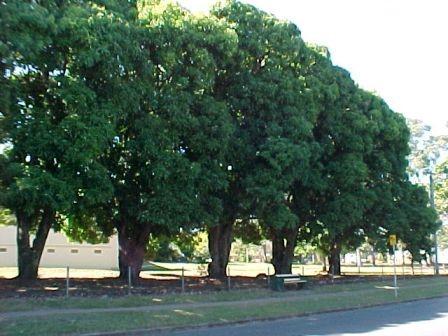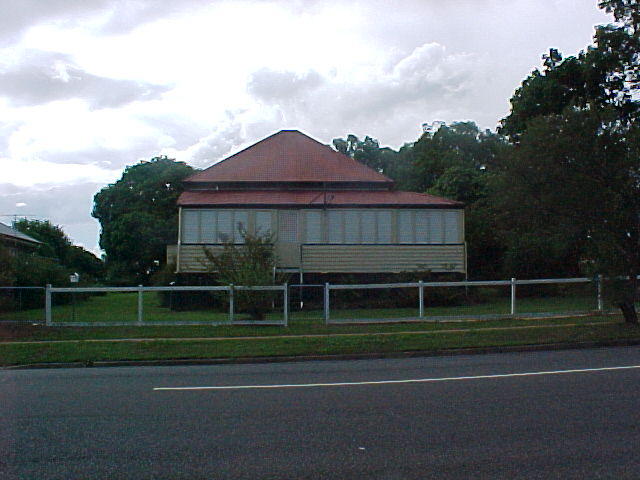Addresses
Type of place
House
Period
Federation 1890-1914
Style
Queenslander
Addresses
Type of place
House
Period
Federation 1890-1914
Style
Queenslander
This cottage was built in 1893 for farmer Ambrose Rode, a member of Nundah’s prominent Rode family. It originally stood facing Earnshaw Road. Rode sold his farm to George Blinzinger in 1910. Blinzinger came from a well-known Nudgee farming family. The cottage was relocated onto a Tufnell Road block within the Blinzinger farm in 1954, when the state government resumed much of the farm for the site for the new Banyo High School (now Earnshaw College). The Blinzinger family retained ownership of this cottage until 2003. It is a rare, being one of only two nineteenth century houses in Banyo.
Lot plan
L1_SP162829
Key dates
Local Heritage Place Since —
Date of Citation —
Construction
Roof: Corrugated iron;Walls: Timber
People/associations
Blinzinger family (Association)Criterion for listing
(A) Historical; (B) Rarity; (H) Historical associationInteractive mapping
Lot plan
L1_SP162829
Key dates
Local Heritage Place Since —
Date of Citation —
Construction
Roof: Corrugated iron;Walls: Timber
People/associations
Blinzinger family (Association)Criterion for listing
(A) Historical; (B) Rarity; (H) Historical associationInteractive mapping
History
On 10 September 1863, Edward Wyndham Tufnell purchased 18 acres of undeveloped land in what was became known as the Nudgee District. He paid £18 for the property that was described as Portion 213 in the Parish of Toombul. Tufnell retained ownership of his land that was centred around the local landmark of Red Hill and fronted a government (soon to be renamed Nudgee) road for 25 years. On 5 November 1888, Ambrose Peter Rode bought the entire property that was now accessed from the main Nudgee Road by Tufnell’s Road.
Ambrose Peter Rode was a member of the prominent Rode family that had developed farms throughout the outer northern districts of Brisbane. Within a few years of his Nudgee District purchase, Ambrose Rode decided to settle on his fruit farm. He took out two mortgages on the land. On 11 September 1893, the recently established Queensland National Bank Limited lent £900 to Rode. This was followed a year later, on 2 November 1994, by a loan of £600 by Joseph McGee, a private financial backer. The loans were sufficient to enable Rode to further develop his farm including having a farmhouse constructed on the land. The residence at 274 Tufnell Road was built in 1893 as farmer A.P. Rode is first listed as a Nudgee resident in the 1894-95 edition of the Queensland Post Office Directories. But it was not constructed facing Tufnell Road; instead, its original location was around the corner facing Earnshaw Road. In October 1894, Rode co-hosted a tour of Nudgee’s orchards and vineyards by the Working Committee of the Fruitgrower’s Association. The purpose was to form a district branch of the Fruitgrower’s Association.
The mortgage owing to McGee had not been fully repaid upon McGee’s death on 10 March 1899. Such was the success and influence of the Rode clan that A.P. Rode’s mortgage was passed onto Charles Joseph Rode along with McGee’s widow Sarah Jane who had been appointed the joint executors of Joseph McGee’s deceased estate.
Ambrose Rode disposed of his house and land to farmer George Blinzinger on 7 June 1910. George was a member of a large German migrant family that had migrated to Queensland in the 1860s. They ran small farms and developed the area. Blinzinger Road was a major road that connected to Nudgee Road until the construction of the Sandgate Railway in 1882. After World War II, the eastern portion of Blinzinger Road was renamed Crockford Street. Unlike the Rode family, the Blinzinger family concentrated their land holdings around the Nudgee District. For example, by 1913, there were nine Blinzingers listed in Nudgee – George & Clara, Gottlieb Heinrich, Herman, Goettlieb & Mary Augusta, Gottlieb & Wilhelmina Catherine & Christina at Northgate Junction (the nearby low-lying farmland now known as Northgate East).
On 2 August 1911, George Blinzinger, aged 36, married the much younger Clara Christina Patzel. In 1912, a railway station was built next to the St. Vincent’s Road rail crossing. Although this rail crossing was known locally as Clapham Junction, the Department of Railways decided to name the new station ‘Banyo’ (supposedly an Aboriginal word for ridge) and the western portion of the Nudgee District became known by this name. George and Clara managed a small farm that was typical of the type to be found throughout Banyo. They grew a variety of seasonal fruit crops, particularly peaches and mangoes while the area now occupied by Earnshaw College was given over to a field of sugar cane. With Nudgee School (1923) and the Nudgee Methodist Church (1928) situated across Earnshaw Road from their farm, the Blinzinger’s small farm was strategically located. But, perhaps, as a result of the financial affects of the Great Depression (1929-39), George mortgaged his cottage and farm through the Queensland National Bank on 17 February 1933. This mortgage was still hanging over the couple’s heads when George died on 7 May 1933. In 1939, the farm and cottage were transferred to the widow Clara and to Albert Robert Grauf who was the co-executor of George’s will.
From 1942-45, during World War II, the US Army built a major supply depot that covered the three corners of the Tufnell and Earnshaw Road intersection, with the Blinzinger farm occupying the land at the fourth corner. Individual US troops would often visit the local farms to obtain private supplies of fresh fruit and vegetables and eggs. But after the War, Banyo began to change. Small farms gave way to housing estates both private and those planned by the Queensland Housing Commission. This urban boom was prompted by the opening in 1947 of the Golden Circle Cannery on ex-US Army land on Earnshaw Road. The opening of the Banyo Rail Workshops in 1958 further boosted population growth.
Land for housing became more valuable than farming. The first subdivision of George & Clara Blinzinger’s farm began in August 1953. The next year, there was a major development. The state government’s Public Works Department resumed a large part of the farm that fronted both Earnshaw and Tufnell Roads on 2 November 1954 for the proposed new Banyo High School (now Earnshaw College). The Blinzinger’s farm was chosen, as it was ideally located across from the local primary school – Nudgee State School. Negotiations between Blinzinger and the Queensland Government were conducted during 1953-54. As a result, on 3 March 1954, Clara contracted the firm of McKenzie & Hoffie to remove her home from Earnshaw Road and relocate it onto the farm’s remnant along Tufnell Road close to the new high school. This remnant comprised 1 rood of land described as Lot 3 on Portion 213. A row of mango trees that were planted on the farm was retained on the school grounds to provide lunchtime shade for students. On 3 August 1954, the Brisbane City Council granted Clara permission to put a garage on her new home site.
Albert Grauf died on 19 December 1968, and ownership of the remaining land (including the cottage) passed to Clara and her relative spinster Mabel Clara Blinzinger. This transfer of ownership met the conditions that had been laid down in George Blinzinger’s 1933 will. George’s widow Clara died on 23 June 1978. On 22 January 1979, her estate was settled and the former farm cottage and remaining land passed to Mabel and George Frederick Blinzinger plus Elsie Mina Schinske and Ruby Christina McEwan. The real property description changed to Lot 3 on 78606 in 1987.
Brisbane City Councillor Kim Flesser and the BANGEE Festival Committee listed the Blinzinger farm site at the corner of Tufnell and Earnshaw Roads as Location 21 of the BANYO-NUDGEE Heritage Trail that was produced in 2000. Members of the local community had been called upon to nominate places of heritage significance for inclusion in this book.
In 2003, the property with its nineteenth century cottage finally passed from the hands of the Blinzinger family. In 2004, the new owner Mr. Newell resubdivided into two smaller allotments and he redeveloped the property. A later-addition, enclosed front verandah was removed from the former farm cottage. It was then moved across to the left so that it occupied only Lot 1 and became 274 Tufnell Road. A similar nineteenth century cottage was then trucked in and placed on Lot 2 and became 274A Tufnell Road. The pair of nineteenth century houses were repainted and given makeovers before being simultaneously put up for sale time. Thus the cottage moved onto Lot 1 still remains within the boundaries of the former Blinzinger farm and backs onto the open fields (former crop fields) that comprise the school sports grounds.
The former farm cottage at 274 Tufnell Road is one of only two nineteenth century buildings left in Banyo. The other is the Robinson farmhouse (former) at 302 St. Vincent’s Road. While both are former farmhouses, each residence is of a different nineteenth century style and so each represents different periods in Banyo’s development. The Blinzinger farmhouse (former) retains its special relationship with Banyo’s high school, given that it remains located on a site adjacent to that school, which itself, is located on the site of the former Blinzinger farm.
Statement of significance
Relevant assessment criteria
This is a place of local heritage significance and meets one or more of the local heritage criteria under the Heritage planning scheme policy of the Brisbane City Plan 2014. It is significant because:
Supporting images

2003 photo, Former Blinzinger farm mango trees planted in a row along Tufnell Road (close to No.274 Tufnell Rd.) but now within the grounds of Earnshaw College.
References
-
Ancestry.com.au, http://search.ancestry.com.au/cgi-bin/sse.dll?gl=35&rank=1&new=1&so=3&MSAV=0&msT=1&gss=ms_f-35&gsfn=geoffrey&gsln=edyveanwalker&msrpn__ftp=Tarragindi%2C+Queensland%2C+Australia&msrpn=100747&msrpn_PInfo=8-|0|1652397|0|5027|0|30096|0|0|100747|0|&sbo=0&uidh=nd5&_83004003-n_xcl=f
-
Bangee Festival Committee, BANYO-NUDGEE Heritage Trail – a pictorial history of Banyo, Nudgee, Nudgee Beach, Virginia and Northgate East, (Banyo: Bangee Festival Committee, 2000)
-
Brisbane City Council, 1946, 2003 & 2009 aerial photographs
-
Brisbane City Council, post-1946 Building Cards
-
Brisbane City Council, Properties on the Web, website
-
Commonwealth Government, Electoral Roll – Division of Lilley – Subdivision of Nundah, 1913
-
Department of Natural Resources, Queensland. Certificates of Title and other records
-
Nundah & Districts Historical Society Inc., Bulletin No.87, September 2011
-
Queensland Post Office Directories, 1868-1949
-
Tremayne, Jean and Pechey, Sue, Pioneers, Picnics and Pineapples, (Brisbane: A.E.B.I.S., 1994)
Citation prepared by — Brisbane City Council (page revised June 2022)

